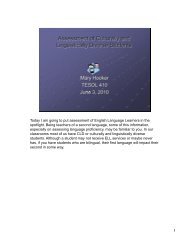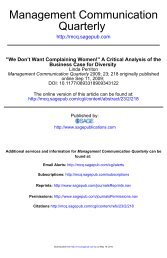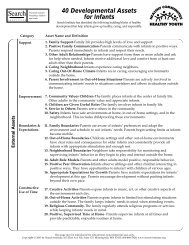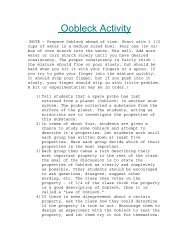Role Plays
Role Plays
Role Plays
You also want an ePaper? Increase the reach of your titles
YUMPU automatically turns print PDFs into web optimized ePapers that Google loves.
SIETAR USA 2002<br />
Creating and Using <strong>Role</strong> <strong>Plays</strong> Effectively<br />
Workshop Facilitator: Christopher Deal<br />
Creating Effective <strong>Role</strong> <strong>Plays</strong><br />
1. <strong>Role</strong> plays should be fun<br />
a. Fun role plays are effective learning tools<br />
b. Fun role plays can energize and create a sense of community<br />
c. Suggestions on making fun role plays (see also third page)<br />
1) Include some element of conflict or irony<br />
2) Putting people in artificial awkward situations (these situations are fun<br />
because they’re not real)<br />
3) Include some mystery or an unknown element<br />
2. <strong>Role</strong> play setup (verbal or written) should provide context and objectives or tasks<br />
a. Each player must know:<br />
Who am I<br />
What am I trying to accomplish<br />
b. Each player might also need to know contextual details or constraints<br />
3. <strong>Role</strong> plays should be open-ended—not scripted<br />
a. Participants find their own way, create their own solutions<br />
b. Allowing participants to be creative improves their learning experience<br />
4. Steps in creating new role plays<br />
a. Begin with conceptual framework or behavioral objective<br />
b. Create situation keeping in mind #1 above (make it interesting or funny)<br />
c. Create roles of appropriate culture/ethnicity, positions, and possibly gender<br />
d. Build in a catch or gimmick that makes it challenging and fun<br />
5. Adapt successful role plays: role plays that have proven effective in one situation can<br />
be adapted to and used in new situations<br />
6. Exaggerations are okay: exaggerated behaviors may highlight relevant points<br />
Additional ideas:<br />
7. Consider using multi-part or serial role plays: can be fun and provide opportunity for<br />
role or position reversal<br />
8. If possible, have participants create and do their own role plays<br />
a. Have them create scenarios relevant to them<br />
b. Have them fill in blank slips and then exchange (as we will do in this workshop)<br />
1) Using their own ideas increases involvement/interest<br />
2) Allows for airing of or discussing problems with anonymity<br />
Copyright © Christopher Deal
Using <strong>Role</strong> <strong>Plays</strong> Effectively<br />
1. Sell it!<br />
a. Show enthusiasm<br />
b. Tell of past successes/enjoyment of participants<br />
c. Emphasize benefits<br />
2. Create appropriate atmosphere<br />
a. Fun, safe, light-hearted learning environment<br />
b. Players should be comfortable with each other (if they don’t know each other,<br />
don’t begin your session with a role play)<br />
3. Remove the audience!<br />
a. Divide the participants into two equal-sized groups (three if role plays has<br />
three roles)<br />
b. Everyone does the role play at the same time<br />
c. By removing the audience, you remove much of the pressure and anxiety<br />
4. Model role playing<br />
a. Do an example with a co-trainer or volunteer<br />
b. Don’t be afraid to “ham it up;” this gives participants license to do the same<br />
5. Give time for preparation<br />
a. Often it’s useful to separate the groups so they can prepare in private<br />
For example: count off A, B, A, B, around the entire room, then say “A’s<br />
please come outside with me, B’s please stay inside, I’ll be right back.”<br />
b. Each group discusses their role and possible approaches or specific phrasing<br />
c. Facilitator(s) coaches and assists groups during the preparation process<br />
6. Assign partners<br />
a. Count off participants from 1 to 10 outside and then do the same inside<br />
b. Instruct participants to find the person with the same number<br />
7. Monitor the role play: inconspicuously listen and observe randomly around the room<br />
8. Stop the role play when the energy level peaks<br />
9. Debrief the role play<br />
a. Invite participants to share their experiences<br />
b. Begin with description, then go to interpretation, then to application<br />
c. Ask volunteers to re-create relevant or interesting parts of their role play<br />
d. Bring the discussion back to the objectives of the training session: stress the<br />
relevance of the role play and the practiced behaviors<br />
10. Develop new ways of using role plays and try them<br />
Copyright © Christopher Deal
Ideas for Creating <strong>Role</strong> <strong>Plays</strong><br />
As previously mentioned, creating role plays that are interesting and funny is essential<br />
to their success. However, in my experience it takes practice to learn how to make good<br />
ones. I suggest that while you’re watching comedies (sit-coms or movies), write down<br />
what made specific situations funny. After a few weeks, you’ll have a list that you can<br />
draw from when creating role plays. Here’s a partial list of mine. Please add your own<br />
to it:<br />
misunderstandings in general<br />
mistaken identity<br />
role reversal<br />
position reversals<br />
being forced to eat your own words<br />
sticky situations<br />
one complains/ the other defends<br />
opposite (or just different) objectives<br />
trying to cover up wrong-doing<br />
trying to cover up embarassing facts or situations<br />
ulterior motives<br />
blackmail<br />
one person reluctantly reveals secrets<br />
job interview<br />
news interview<br />
a person’s good side/bad side (angel or devil on each shoulder)<br />
Copyright © Christopher Deal
















